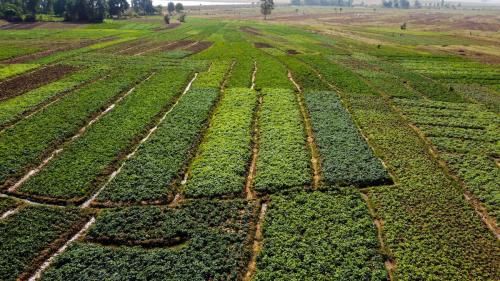“The Earth in the coming decades could cease to be a ‘safe operating space’ for human beings,” concludes a paper by 18 researchers “trying to gauge the breaking points in the natural world,” published in Science in January 2015. That our planetary environment seems to be approaching “breaking points” is but one of several systemic threats looming on the horizon or lurking under the surface.
Since the economic crisis in 2008, the world has learned that financial instability is a global threat to sustainable livelihoods and economic progress. The underlying dynamics of technological change seem to be more labor displacing than labor absorbing, creating increasing anxiety that employment and career trajectories are permanently threatened. These two challenges undermine public confidence in the market economy, in institutions, and in political leaders. They constitute systemic threats to the credibility of markets and democracy to generate socially and politically sustainable outcomes for societies.
The fact that one billion people still live in extreme poverty, that there are scores of countries that are considered to be “failed states,” and that genocide, virulent violence, and terrorism are fed by this human condition of extreme deprivation together constitute a social systemic threat, global in scope. These challenges together merge with a growing public awareness of global inequality between nations and of increasing inequality within nations. The power of money in public life, whether in the form of overt corruption or covert influence, disenfranchises ordinary people and feeds anger and distrust of the current economic system.
These systemic threats constitute challenges to planetary, financial, economic, social, and political sustainability. These are not just specific problems that need to be addressed but pose severe challenges to the viability and validity of current trends and practices and contemporary institutional arrangements and systems.
Systemic sustainability is the strategic imperative for the future
These challenges are global in reach, systemic in scale, and urgent. They require deliberate decisions to abandon “business-as-usual” approaches, to rethink current practices and engage in actions to transform the underlying fundamentals in order to avoid the collapse and catastrophe of systems that average people depend upon for normal life.
Systemic risks are real. Generating new pathways to systemic sustainability are the new imperatives. Holistic approaches are essential, since the economic, social, environmental, and political elements of systemic risk are interrelated. “Sustainable development,” once the label for environmentally sensitive development paths for developing countries, is now the new imperative for systemic sustainability for the global community as a whole.
Implications for global goal-setting and global governance
2015 is a pivotal year for global transformation. Three major work streams among all nations are going forward this year under the auspices of the United Nations to develop goals, financing, and frameworks for the “post-2015 Sustainable Development Agenda.” First, in New York in September—after two years of wide-ranging consultation—the U.N. General Assembly will endorse a new set of global development goals to be achieved by 2030, to build upon and replace the Millennium Development Goals (MDGs) that culminate this year. Second, to support this effort, a Financing for Development (FFD) conference took place in July in Addis Ababa, Ethiopia, to identify innovative ways to mobilize private and public resources for the massive investments necessary to achieve the new goals. And third, in Paris in December, the final negotiating session will complete work on a global climate change framework.
These three landmark summits will, with luck, provide the broad strategic vision, the specific goals, and the financing for addressing the full range of systemic threats. Most of all, these events, along with the G-20 summit of leaders of the major economies in November in Antalya, Turkey, will mobilize the relevant stakeholders and actors crucial for implementing the post-2015 agenda—governments, international organizations, business, finance, civil society, and parliaments—into a concerted effort to achieve transformational outcomes. Achieving systemic sustainability is a comprehensive, inclusive effort requiring all actors and all countries to be engaged.
[3]
Four major elements need to be in place for this process to become a real instrument for achieving systemic sustainability across the board.
First, because everyone everywhere faces systemic threats, the response needs to be universal. The post-2015 agenda must be seen as involving advanced industrial countries, emerging market economies, and developing nations. Systemic sustainability is not a development agenda limited to developing countries, nor just a project to eradicate poverty, nor just an agenda for development cooperation and foreign aid. It is a high policy agenda for all countries that goes to the core of economics, governance, and society, addressing fundamental dynamics in finance, energy, employment, equity, growth, governance, and institutions.
Second, systemic threats are generated because of spillover effects from activities that used to be considered self-contained and circumscribed in their impact. The world of silos and vertical self-sufficiency has given way to an integrated world in which horizontal linkages are as important as vertical specialization. The result of these interlinkages is that synergies can be realized by taking comprehensive integrated approaches to major issues. In this new context, positive-sum benefits are potentially more easily realized, but integrated strategies are necessary for doing so.
This new context of spillovers and synergies has two implications. The domestic dimension is that whole-of-government approaches are necessary for addressing systemic sustainability. Cross-sectoral, inter-ministerial approaches are essential. Since markets alone are not able to realize optimal outcomes in the widespread presence of externalities, the only way to realize the positive sum potential of synergies is through coordination among related actors. On the international dimension, this new context also requires more cooperation and coordination than competition to realize synergistic, positive-sum outcomes.
Third, domestic political pressures are primary. This may be a variant of the old saying that “all politics is local.” However, the aftermath of the 2008 global financial crisis has been a world of hurt in which impacted publics are feeling anger and alienation from an economic system that has threatened their jobs, incomes, pensions, homes, and livelihoods. The task of leaders is not to pander to these plights but to lead their people to understand the vital linkage between domestic conditions and external forces and the degree to which the global context inevitably impacts on domestic conditions. Leaders need to be able to explain to their people that systemic threats have inextricable global–domestic linkages that need to be managed, not ignored.
Fourth, given all this, it is absolutely necessary that the global system of international institutions be “on the same page,” share the same vision, strategy, and goals, rather than each taking its primary mandate as a writ for independence from the common agenda.
The major challenges for global governance in this pivotal turn from goal-setting in 2015 to the beginning of implementation in 2016 are to ensure (i) that all countries adapt and adopt the post-2015 agenda in ways that are congruent with their national culture and context while at the same time committing to reporting on all aspects of the agenda; (ii) that whole-of-government institutional mechanisms and processes are put in place domestically to realize the synergies that can accrue only from comprehensive, integrated approaches and that international cooperation mechanisms gain greater traction to reap the positive-sum outcomes from global consultation, coordination, and cooperation; (iii) that national political leaders learn new modes of domestic and international leadership that are capable of articulating the new context and new systemic risks that need to be managed both internally and globally; and (iv) that each international institution realizes the need to be part of a system-wide global effort to achieve systemic sustainability through concerted efforts of all relevant actors working together on behalf of a common global agenda.
[2]
The Sustainable Development Goals as guidelines to systemic sustainability
Currently under discussion are 17 Sustainable Development Goals (SDGs) and 169 indicators for 2030 to extend and replace the eight MDGs for 2015, which had 21 targets and a variety of indicators, which in turn extended and replaced seven International Development Goals (IDGs) agreed to in 1995 by development cooperation ministers from OECD countries. There is much chatter now about whether the SDGs and indicators are too many, too ambitious, and too widespread. The Economist asserts that the SDGs “would be worse than useless,” dubbing them “stupid development goals”. And Charles Kenney at the Center for Global Development in a thoughtful piece argues that “we lost the plot.”
It may be true that there is too much detail. Two previous efforts, one by the Centre for International Governance Innovation (CIGI) and the Korean Development Institute (KDI) had 10 goals, and the other, the U.N. High Level Panel of Eminent Persons report in 2013 had 12 goals.[iii] This quibble alone does not prevent the use of political imagination to conjure a storyline that connects the 17 proposed SDGs with the vision of the post-2015 Sustainable Development Agenda as addressing systemic threats and having comprehensive integrated strategies for addressing them.
Fourteen of the 17 SDGs can be clustered into four overarching strategic components: poverty (2); access (6); sustainability (5); and partnership (1). The other three goals have to do with growth and governance (institutions), which were underpinnings for both the IDGs and the MDGs though not embodied in the sets of goals themselves. The four SDG components seamlessly continue the storyline of the IDGs and the MDGs, both of which included poverty as the first goal, gender equality- education-and-health as issues of access, an environmental sustainability goal, and (in the MDGs) a partnership goal. The two underpinning components of growth and governance remain crucial and, if anything, are still more important today than 20 years ago when the global goal-setting process began.
Continuity of strategic direction in transformational change is an asset, ensuring persistence and staying power until the goal is fulfilled.
The SDGs now convey a sense of the scale and scope of systemic threats. The sustainability goals (goals 11 through 15) highlight the environmental threats from urbanization, over-consumption/production, climate change, destruction of ocean life, to ecosystems, forests, deserts, land, and biodiversity. No knowledgeable person would leave out any of these issues when considering threats to environmental sustainability.
The fact that goal 10, to “reduce inequality within and among countries,” is on the list of SDGs signals a new fact of political life that inequality is now front-and-center on the political agenda globally and nationally in many countries, advanced, emerging, and developing. This goal is really the “chapeaux” for goals 3 through 7, which deal with health, education, gender, water and sanitation, and energy for all—the access goals that must be met to “reduce inequality within and among countries.” It is inconceivable that a group of global goals for a sustainable future in the 21st century would leave out any of these goals crucial for achieving social sustainability, and undoubtedly political sustainability as well.
Reducing inequality is not an end in itself but a means of providing skills and livelihoods for people in a knowledge-based global economy and hence the social and political sustainability required for stable growth. Growth is both a means and an end.
The two poverty goals are now more ambitious and inclusive than earlier. “Ending poverty” is different from reducing it, as in the IDGs and MDGs. And “ending hunger” through food security, nutrition, and sustainable agriculture are means to the end of eliminating poverty. For the Economist, eliminating extreme poverty should be the most important goal, stating that “it would have a much better chance of being achieved if it stood at the head of a very short list.”
This observation would apply if the SDGs are again intended to be, as the IDGs and MDGs were previously, development goals for developing countries. But development for developing countries is not the primary thrust and drive of the post-2015 agenda taken as a whole.
The world is now facing systemic risks that threaten unacceptable collapse in social, political, economic, and environmental systems. A global community under threat from systemic risks needs a strategic vision and a pathway forward with specific guideposts, benchmarks, and means of implementation.
The SDGs, the FFD documents and the U.N. Framework Convention on Climate Change accords will not be perfect. But, the three U.N. processes in 2015 capture the main elements, attempt to get specific in terms of priority actions and accountability, and together will provide a vision for the future for achieving systemic sustainability in its multiple, interconnected dimensions.
To think that simplifying the wording is going to simplify the problems is illusory. To narrow the vision to poor countries and poor people is to misunderstand the systemic nature of the threats and the scope and scale of them.
This is a global agenda for all. Partnership now means we are all in the same boat, no longer acting on a global North-South axis of donor and recipient. Without the participation of all nations, all stakeholders, and all the international institutions, actual transformation will fall short of necessary transformation, and the world will reach breaking points that will inflict pain, suffering, and high costs on everyone in the future. The post-2015 Sustainable Development Agenda for 2030 brings an awareness of the future into the present and makes us understand that the time for action is now.
Endnotes:
[1] For an example of a recent multistakeholder interactive conference on this set of issues, review the related report on the Brookings-Finland private meeting on March 30, 2015 on “implementing the post 2015 sustainable development agenda.
[2] See “Action Implications of Focusing Now on the Implementation of the post-2015 Agenda,” which outlines in more detail the key elements of implementation that need to be set in motion during 2015 and 2016, emphasizing especially roles for the Turkey G-20 summit in 2015 and the China G-20 summit in 2016.
The Brookings Institution is committed to quality, independence, and impact.
We are supported by a diverse array of funders. In line with our values and policies, each Brookings publication represents the sole views of its author(s).




